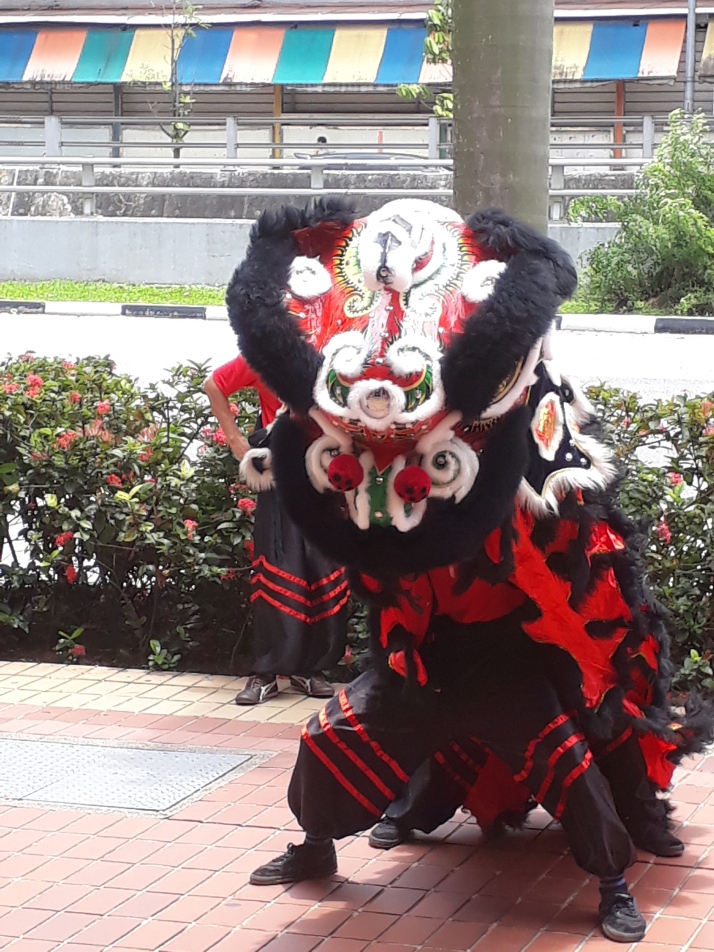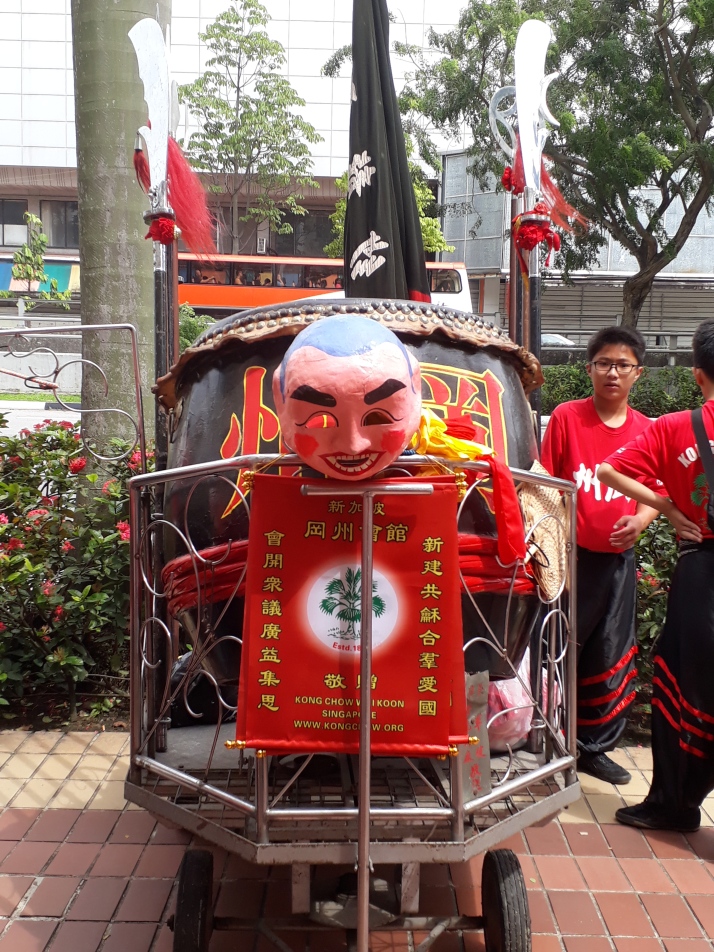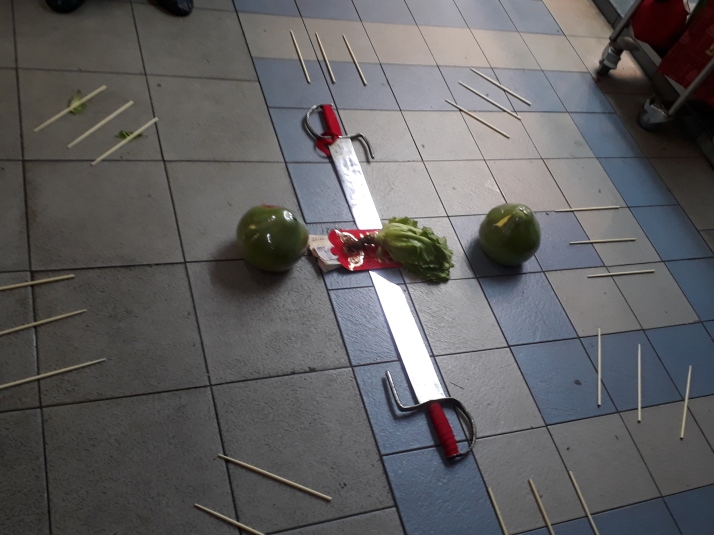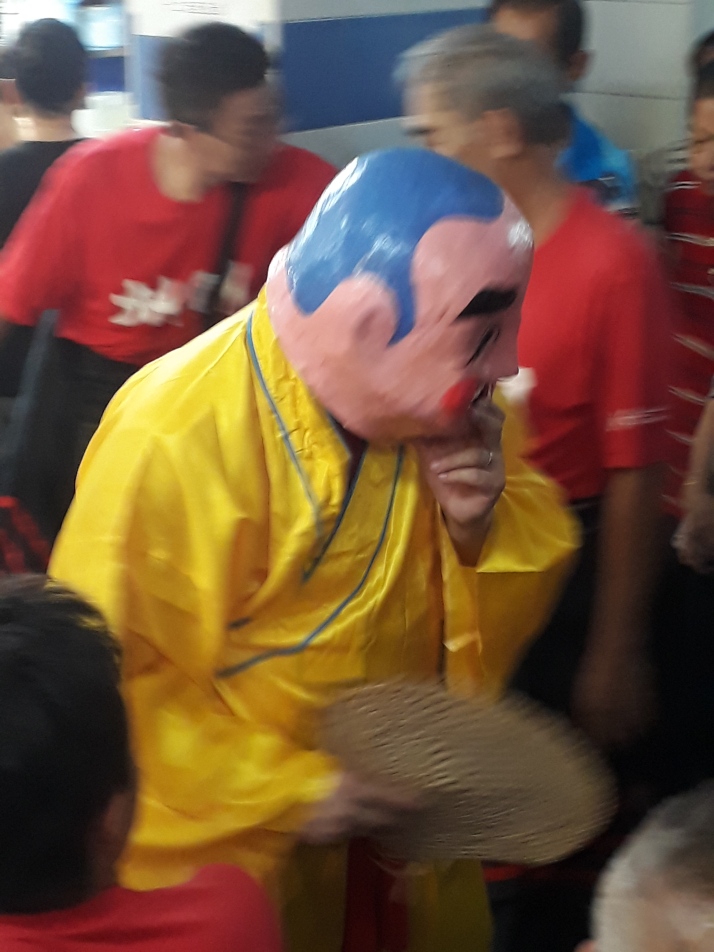
A pair of lion dancers performing a series of ritual ‘steps’ outside the Kong Chow Wui Koon before it enters the clan premises.
I’d written before on the captivating energy of the lion dance – as an outsider looking in, the clamour of the gongs and cymbals and the colour and vigour of the dancers seem like a hallmark of cultural artistry to some, and a fantastic spectacle to most. It was only after I had gotten a chance to join the lion dancers at the Kong Chow Wui Koon (岡州会馆) along New Bridge Road that I gained a tiny glimpse into the world that really exists behind these performances.
One of Singapore’s oldest Chinese clan associations, the Kong Chow Wui Koon was set up as a support centre for early Cantonese migrants to the region in the mid-19th century (‘Kong Chow’ refers to a collection of eight provinces in the Pearl River Delta). The gilded Chinese characters on the plaques around the door and orange banners flanking the gate make the clan building appear like something out of a Shaw Brothers film. On the ground floor of the four-storey building sits a long table surrounded by heavy polished wood chairs, and on the top floor sits a large altar dominated by a statue of Guan Gong, the Chinese god of war. Many of the old and middle-aged men who saunter through its gates had practiced some form of southern Chinese martial arts, having learnt from the disciples of masters who arrived from Canton. As one of them explained to me, “lion dancing is a martial art” – a natural extension of their practice.
A member of the clan had opened a chicken rice stall in April at the Chinatown Complex Food Centre and had paid three southern lion dance troupes to perform before their shop for good luck – Kong Chow’s was the first. Their style of lion dancing featured low, strong martial stances brought over from the Hung Gar style of martial arts.“The traditional type, not like those commercial groups,” said one of the clan’s martial artists in Mandarin, a tall strongly-built man known among them as ‘Peng Kor’ (‘brother Peng’). “Last time, every lion dancer knew martial arts, but now those commercial troupes have lost the martial arts foundation. When you watch them you can yawn because it’s not as well-done.” But these same commercial troupes, sporting flashier stunts and more colourful costumes, provided unfortunate competition for troupes like the clan’s that chose to stand by tradition. That afternoon’s gig was one of the few they had received in the year.
Around thirty clan members and performers had turned up by 10 in the morning – a mix of grizzled old ‘sifu‘s (Cantonese for ‘master’) and the lanky teenagers who’d be performing the physically demanding dance. One of the elders, a small wiry man with a silvering crew cut and thin sinewy arms, gave me a toothy grin. “Don’t your parents disapprove of you doing this?” he asked, curious. Tales from other clan veterans abounded of lion dance ‘challenge matches’ in the mid-20th century: lion heads reinforced with metal that were used to charge into and shred the costumes of other troupes, performers with hidden daggers, and the bitter fights that used to result between rival different Chinese clan associations. Today, the lions are made to be more vibrant than violent. A pair of red-trimmed black lions sat, bright-eyed and open-mouthed, at the edge of the table facing the door. Their colour marked them out as Liu Bei lions, named for one of the three sworn brothers from the historical epic Romance of the Three Kingdoms and meant to symbolise valour and honour.
Outside, the rows of traditional Chinese weapons lining the cart that would be used to tow the lion head to the performance venue stood as a lingering trace of the art’s darker past. After a quick breakfast of fried bee hoon and tea, the men changed out into the red clan shirt and dark baggy ‘kung fu pants’ with matching sashes. The sash is always tied to the right, which represents the ‘martial’ (武) as opposed to the ‘civil’ (文) on the left. Two performers slid into each lion costume, ‘possessing’ it – for traditionally the lion is never just seen as a costume piloted by a pair of men, but a semi-divine creature dedicated to fighting evil with the mirror and horn on its forehead. Drum beats pattered out a quick rhythmn, and the lions came to life. Bowing to the altar of the gods and the ancestors on the fourth and third floors, they made their way downstairs, accompanied by the raucous din of drum, cymbals and gong.
A crowd of fascinated onlookers had already gathered along the pavement when the lion performed a series of ‘steps’ to indicate it was leaving the clan premises. A stocky older man (usually it’s the senior members that are allowed to play the drum) stepped onto the cart and began drumming out the lion dance’s distinctive beat. With two boys bearing the rectangular orange banners emblazoned with the clan’s name, we set out.

The cart traditionally used to transport lion heads over short distances. The scrolls displayed at the front are presented to hosts during the performance, such as the owners of a house or shop that the lion dance is staged at.

An old clan member with the Liu Bei lion heads on top of the large leather drum used for the performance. The clan insigna is visible on the back of the second lion head.

The Kong Chow Wui Koon clan members on their way. The drum and cymbals are played throughout the journey not just as an announcement, but to symbolise the lion’s ‘heartbeat’.
On the floor of the food centre were 24 wooden chopsticks. They were arranged in the shape of the bagua, or Eight Trigrams, a Taoist cosmological symbol representing heavenly principles. A pair of butterfly knives gleamed in the centre, their tips concealed by a head of lettuce and a red packet containing wads of money to be divided among the performers. Two pomelos flanked the arrangement, to be ‘eaten’ by the lion along with the lettuce. I had never seen it before – much more common was cai qing, where the lion would spit shredded lettuce into the audience and arrange mandarin segments into auspicious phrases. It was much later that I learnt it had a more esoteric significance – by breaking into the chopstick formation, the lion, as a purveyor of good luck, was meant to ‘unlock’ the fortunes of the shop-owners ‘trapped’ within, with the fruit and vegetables representing a wish for prosperity and continuity down the generations.
The crowd had swelled by the time we arrived, prompting two of the elders to swiftly set up a cordon around the stall. Boxes of canned green tea had been laid out for the clans members – standard refreshment as thanks for the performance. The lions rushed in, bowing before the storefront as the owners reached out to pet them for positive energy. They circled the formation, blinking, with quick exploratory steps, and one by one each of the chopsticks disappeared. A ‘Big-Head Buddha’ stepped in, a common accompaniment to many lion dances, fanning himself as he searched the area with swaggering steps. He found a dagger, picked it up, pretended to prick himself and dropped it, nursing his hurt finger. Eventually the lions returned, and reared back to shower shreds of lettuce all over the storefront to the visible satisfaction of the owners. The movements were small and tight, the performance long-drawn: this was not the crowd-pleaser that lion dancers seen at Chinese New Year shows and the openings of big shops would do. But it was nonetheless important for its ritualistic element – something which, perhaps, is no longer found in many modern dances.
A more surprising element was, for me, still to come. As we were walking back, we were greeted by a different set of cymbal-clashes from the Hok San Association down the street. “They’re coming to perform in the afternoon,” one of the teenage performers explained. “So since we’re passing by, we have to go over and greet them. If you don’t… last time there’d be trouble. We used to have a not-so-good relationship until some of the seniors in the clan decided to reach out recently.” The two pairs of lions circled each other, sniffing, while the elders walked over and cordially shook hands. When we had returned, we saw that they had come over to greet the clan too, making a detour from their original route. Such were the intricacies of lion dance etiquette that few else got to see, I thought.
The music died down. The lions, having finished paying respects to the deities again, were returned to their original position on the table. The dancers slumped, exhausted, into any chair they could find. An old, balding man with a white towel around his neck went around passing pink envelopes to everyone who had performed. The lanky, tall eighteen-year-old next to me drew out a single ten-dollar bill. “You don’t get much money one lah,” he said with a sheepish smile. “At Chinese New Year the most you get is around one hundred dollars for performing the whole day.”
The next week, the teenagers would all be back at school. They might not dance again due to other commitments. And the troupe would struggle to sustain itself as it refrains from participating in the competitions and commercial gigs that have lately filled the lion dance scene. But there would always be this group of clan members that would doggedly try to keep the martial style of lion dance alive.

The bagua formation formed at the food centre as part of the performance.

The lions making their grand entrance at the Chinatown Complex Food Centre.

The ‘Big Head Buddha’ in the middle of the crowd. He carries a fan and walks with exaggerated, comical movements to add a comedic element and mark interludes within the performance.

The troupe from the Singapore Hok San Association, Singapore’s oldest lion dance group.

A senior member of the Kong Chow Wui Koon directing the interaction between the two pairs of lions. In the past, failure to greet another troupe properly could result in severe fights.
It’s wonderful to get a glimpse inside the dance. I had no idea of the martial arts link, but now that you’ve mentioned it, it seems like one of those things I should have known–but of course didn’t. Thank you for the post.
LikeLiked by 1 person
Honestly I feel like I’ve only scratched the surface – I’ll probably be posting more on this topic in the next few weeks because I got backstage access to one of the clan’s biggest events. The martial arts connection is something even very few Chinese people know about – even if that link seems so intuitive when you think about it. (I was the only girl there, if that says anything XD) Thanks for following, and leaving a comment too! 🙂
LikeLike
Such a wonderful tradition. Encompassing dance, theatre, tradition and food!
LikeLike
Oh, the food is only there as one of the perks of performing xD It’s customary to get some snacks and drinks before and after the dance because you’re basically doing the hosts a favour. Thanks for dropping by!
LikeLiked by 1 person
Even better. Food and good company before and after!
LikeLike
Oh the last time we saw one was quite some years back. It never fails to amaze us how we seem to only hear the sounds but not see it. Blame it on the crowds!
LikeLike
Oh yeah, the crowds – the clan members even told me that some tourists would climb up to the rooftop of the building to watch rehearsals thinking those were the real dances! Previously I would always try to squeeze my way to the front to watch them, but now that I’ve begun trying to follow the clan on their gigs it’s interesting to get more of a ‘backstage’ view on it.
LikeLiked by 1 person
There is also this competition held annually we recall. At Ngee Ann city we think, where teams from around the world come to compete over obstacles…
LikeLike
Oh yeah, that one’s still going on! It’s always around Sago Street if I’m not wrong. I’ve wanted to watch it myself many times but got turned off by the entrance fee, haha!
LikeLiked by 1 person
The first picture is well taken. I feel it captures the strength of the stance beautifully.
LikeLiked by 1 person
Thanks! I only had my phone camera on me at the event so there aren’t many usable pictures unfortunately. And it really does take a lot of strength and skill to manipulate those lion heads – one can easily come up to 3kg and you’d have to jump around with it!
LikeLike
Pingback: An Evening with Sar Kong Lion Dance | Hear The Flowers Sing